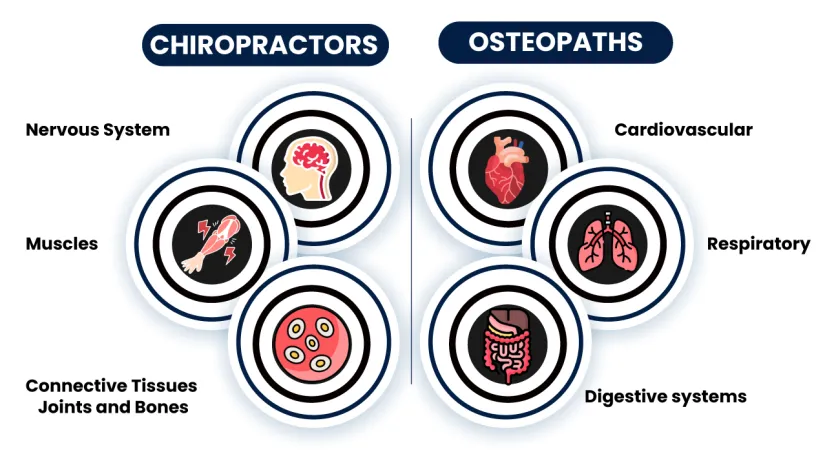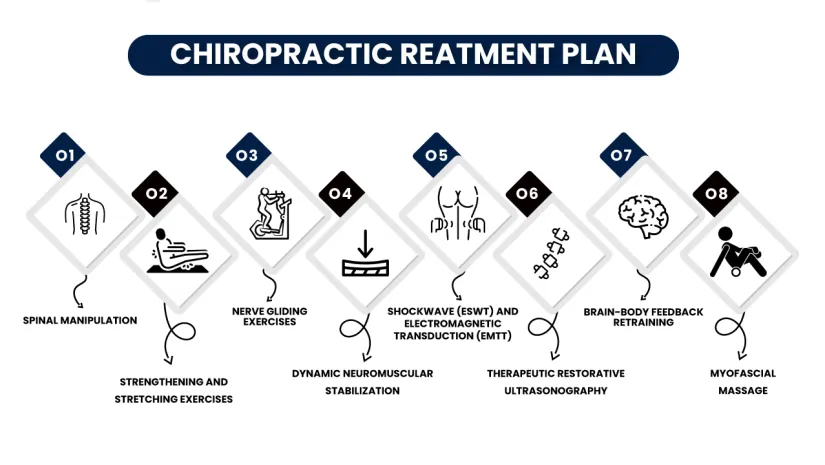When your back hurts (or you can’t turn your neck), you might wonder who to call for help. It can be confusing for some patients as to what the difference between osteopath and chiropractor treatments. Chiropractor or Osteopath—Who to See for Your Problem. Is one better than the other? What do they practice?
This will enable you to make an informed decision on where to turn for assistance with your joint, muscle, or general body pains. Well, by the end of this blog, you will have definite clarity on what each practitioner does, their training, how their treatments work, and some answers to questions like “Is a chiro a doctor?” or “Are osteopaths medical doctors?” You’ll know what to expect at your initial visit and what kind of care to choose for yourself.
What Is a Chiropractor?
They tend to specialize in the spine. Their primary conviction is that numerous health issues are caused by slight misalignments in your spine and joints. Chiropractors crack, or adjust, the spine using their hands. This is known as spinal manipulation. They believe a properly aligned spine helps the body heal itself.
It originated in date back to the late 1890s in the United States. It’s based on the theory that if bones become twisted or otherwise out of place, they can disrupt nerves and therefore health, a theory co-founder D. D Palmer had. Chiropractors in this day and age will assist you with back pain, neck pain, headaches, and tight muscles. We have all heard people say, “Are chiropractors doctors?” In fact, chiropractors are referred to as “doctors of chiropractic” (DC); however, they are not medical doctors. To do that, they need to go to a special university, need to take exams, and need to get a license to do that.
Chiropractic treatment of such problems commonly involves:
- Lower back pain
- Neck stiffness and pain
- Sciatica (pain felt down the back of the leg)
- Cervicogenic headaches.
What Is an Osteopath?
Osteopaths are full-body practitioners, not just back practitioners. They say your bone health, muscle health, nerve health, and even organ health is all connected. Osteopathic manipulation: Osteopaths apply gentle hands-on treatment called osteopathic manipulation. There are no special treatments, only stretching, massaging, and a little pressure. Osteopaths may also provide guidance on exercise, posture, and other elements of lifestyle.
Osteopathy was also born around the same time as chiropractic services. It was developed in the United States in the 1870s by Dr. Andrew Taylor Still. If everything is balanced and doing what it should, the body can take care of itself,” he added.
Are osteopaths doctors? You might ask, “Are osteopaths medical doctors?” or “Is an osteopath a medical doctor?” Where you live is a factor here. Here in the United States, you have “Doctors of Osteopathy” (DOs) who have gone to medical school, can prescribe medicine, and can cut you open in a surgical procedure. Unlike in the US, where they are medical doctors, osteopaths in places like the UK and Australia are not, but they are trained to work with muscles and bones.
Osteopaths often treat:
- Joint and muscle pain
- Sports injuries
- Headaches
- Pain with movement or posture
- Training and Qualifications
Training and Qualifications
How Chiropractors are Certified?
A chiropractor trains for several years beyond undergraduate college. That means learning about the body and how to take care of patients in a clinic, and passing exams. And right off the bat, after all of that schooling, they take high-stakes national and state tests — and they must keep learning throughout their careers.
Though called doctors, chiropractors have not attended medical school. Chiropractors specialize in treating, determining the root cause, and providing the best solution for disorders of the musculoskeletal system.
How Osteopaths are Certified?
Osteopaths’ training is different between countries. In countries other than the US, osteopathy is a university degree, taking four to five years. This training is on the body’s muscles, bones, joints, and soft tissue treatments. Osteopaths are constrained by regulations established by their country’s health boards.
Remember, in the US, even osteopaths (DOs) go to medical school, so they are “doctors.” In other places, they are not doctors of medicine, but they are required to be registered and licensed.
What it boils down to is that there is a difference between osteopath and chiropractor in terms of education and title. It’s a good idea to verify your practitioner’s credentials and training.
Core Philosophies and Techniques
Chiropractic Approaches
Chiropractors primarily treat the spine and joints. They do “adjustments,” in which they jerk you back and forth to try to help things line up as they think they should. The heavens may open, and there may be a “pop” or “crack.” It can be useful for stiffness, pain, and occasionally headaches.
For those who prefer gentler treatments, they may use tools or apply soft pressure. Some chiropractors recommend stretches, exercises, or other ways to relieve the stiff or painful areas of your body, though the employment of such measures is questionable.
The emphasis is on the spine. The idea is that healthy spines make it easier for nerves to do their job and thereby improve how your body works, too.
Osteopathic Methods (Osteotherapy)
Osteopaths check out the entire body, not just the spine. The whole body is treated by stretches, gentle and light touches, joint massage, and its movement. This approach is typically called osteopathic manipulation.
The best way to relax the body is “cranial osteopathy”. This involves light touches on the head or sacrum to reduce strain.
They can also advise you on exercises, posture, movement, and general lifestyle. The idea is to even out the body so it can heal itself.
Osteotherapy vs Chiropractor: Key Similarities and Differences

The main difference between osteopath and chiropractor is in what they concentrate on. Both practice hands-on methods, treating pain and muscle disorders, and both espouse the view that the body can, and should, heal itself. But chiropractors tend to look primarily at the spine, whereas osteopaths look more at the whole body.
Both can be a light touch or a sturdier touch; both aim to decrease pain and change how you move. But osteopaths commonly address more varied health problems, including issues with muscles, bones, joints, and occasionally organ function.
You might read about “osteopathy vs. chiropractor.” This slogan compares their style of treating people. Osteopaths stretch, massage, and treat more parts of the body; chiropractors typically focus on the spine. Both can have their uses, depending on the problem you’re trying to solve.
Regulation, Safety, and Professional Oversight
There are stringent standards that chiropractors and osteopaths need to meet. They have to be licensed and are subject to the regulations of their country. Their skills are kept sharp through regular training.
There are also governing bodies that set standards for chiropractors, such as the American Chiropractic Association or the UK’s own group called the General Chiropractic Council. For osteopaths, checks are received via organizations such as the General Osteopathic Council (UK) or state boards.
Are Osteopaths and Chiro Doctors?
This is a key question. Are chiropractors doctors (if ever requested)? Yes (but not an M.D.). Chiropractors have a Doctor of Chiropractic (DC) degree. And they are not MDs, so they can not prescribe medicine or perform surgery.
Which leads to the question, Are osteopaths medical doctors? (If you ask) Or “What about the osteopath? Is this a doctor?” It depends on the country. Doctors in the US are fully licensed, practice-owning physicians. In other locations, osteopaths work on bones and muscles rather than prescribing drugs and performing surgeries.
Common Patient Questions and Treatment Scenarios
When Should You See a Chiropractor or Osteopath?
If you’ve got back or neck pain, perhaps you’d choose a chiropractor for spinal manipulation. If you’re looking for soft-touch, hands-on assistance with muscles and joints, an osteopath may be a better fit. Both can be a salve for aches and pains, but they have different styles.
You may want to visit a chiropractor if you have:
- A stiff neck or back, Sciatica, Headaches from your neck.
- If you have it, you might see an osteopath.
- General body pain, Muscle or joint aches, Sports injuries, and Pain from posture or movement.
What Can You Expect in an Appointment?
Whichever the case, the first time you visit, either professional will ask you some questions about your symptoms, observe your movement, and probably talk to you about your health in general. Spine X-ray: The chiropractor may recommend this test. Osteopaths typically use touch, stretching, and massage.
Both will inform you of the plan, and you will get to ask some questions. You can expect to be sore for a day or two following treatments, but this is typically mild.
How Should You Choose?
Verify qualifications and licenses. Ask about their style. Discuss your health needs, the things you want to fix. Test out who makes you most at ease and make certain to discuss everything that concerns you.
It also doesn’t hurt to inquire about insurance and costs ahead of time.
Evidence, Effectiveness, and Controversies
There is a large body of research on both subjects. For some back and neck problems, there is evidence for hands-on care. Some people get pain relief from both osteopaths and chiropractors.
But some doctors and scientists say there is a need for more studies. The media sometimes ask if their treatments work for everyone. It’s nice to think that there are ways to do things in life that are a little bit naughty and dangerous.
If you’re asking yourself, “Are chiropractors legit?” or “Is an osteopath a medical doctor?” is that both fields are regulated and studied, but not everyone is going to benefit in the same way.
Get your own doctor’s go-ahead before you begin a new treatment, particularly if you have other health issues.
Making Smart Choices for Your Health
Knowing the difference between osteopath and chiropractor helps you find the right expert for your body’s needs. Chiropractors see the spine as the “axis” of this wheel and an important factor in overall health, so they tend to zero in on spinal adjustments, but because biomechanics don’t operate in isolation, the whole body is considered in an adjustment.
If you’re considering care, examine your provider’s background, ask questions, and talk to your family doctor. The right pick is the one that you find most comfortable and will be able to wear to help and manage your symptoms!
Want to learn more? “Get Started Today. Don’t wait for the pain to worsen. Schedule a consultation with Nicali Sports Medicine & Associates today and learn the difference between osteopath and chiropractor. Call us or book online—we’re ready to help you move freely again.”
FAQs
What is the difference between a chiropractor and an osteopath?
The biggest difference between osteopath and chiropractor is that: chiropractor mainly handles spinal care. While osteopaths take a more holistic view of the body. They both use hands-on methods, but osteopaths are usually less aggressive and look beyond bones and joints.
Are osteopaths medical doctors?
It depends on the area of living. Osteopathic physicians (Doctor of Osteopathy) go to medical school in the United States. Outside the United States, they are trained and licensed in osteopathy but are not medical doctors.
Is a chiro a doctor?
Chiropractors have a doctoral degree in chiropractic. They are not getting an MD, so they are not medical doctors, but they are trained to help with musculoskeletal problems.
Osteotherapy vs chiropractor—which is better for my back pain?
Osteopathy vs. Chiropractor for Back Pain is a question of your needs. Want your spine cracked? Go to a chiropractor. You can also opt for osteopathy if you like gentle treatment and advice for the entire body.
Are treatments safe, and what are the risks?
Such treatments are safe for most, but always confirm your provider’s training. Share your health challenges with them before you start something new, and question them.


